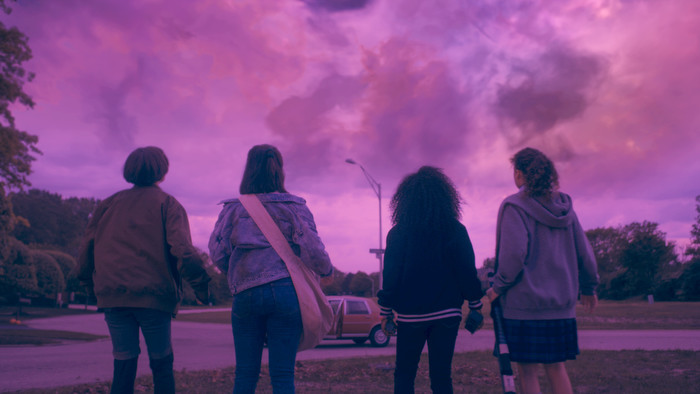
Hours before dawn on Nov. 1, 1988, four suburban middle-school girls venture out to deliver newspapers and dodge threats from teen bullies slinking home after a long night of Halloween mischief. In search of the boys who stole their walkie talkie, they bust into an under-construction house, come face-to-face with a pair of apparent mutants, and flee into deserted streets under an angry, unnaturally fuchsia sky. Instead of fighting bullies, they’re caught in some cosmic war.
Paper Girls, which comes to Amazon on July 29, sounds a lot like Stranger Things—but for girls! And if that’s what gets you to watch, so much the better. But this coming-of-age sci-fi series, based on a comic written by Brian K. Vaughan (best known for Y: The Last Man and Saga) and illustrated by veteran artist Cliff Chiang, tells a more focused, character-driven story that is particularly refreshing on the heels of the Netflix epic’s bloated fourth season.

A time-travel show more than a serialized creature feature, Paper Girls introduces its central foursome on the precipice of adolescence. Erin (Riley Lai Nelet) is wrapped up in family obligations, as the designated translator for her Chinese-immigrant mother. Tough-talking, secretly tenderhearted Mac (Sofia Rosinsky) comes from a troubled home and aspires to be just like her delinquent older brother. She locks horns with privileged, private-school jock KJ (Fina Strazza). Tiffany (Camryn Jones), the resident genius, stays laser-focused on her studies, which she hopes will one day take her far away from their sleepy, small-minded hometown.
The girls all harbor visions of a future that is better than the present, whether that means becoming President or just escaping the expectations of parents who don’t understand who their daughters really are. But when their cataclysmic post-Halloween morning leads to a journey through time, into 2019 and beyond, each gets a glimpse at a future that forces her to reevaluate the present. That’s a lot of processing to demand from 12-year-olds who are also trying to extricate themselves from a war unfolding across timelines between two factions from the future—one a scrappy crew of young people who want to use time travel to fix humanity’s worst mistakes and the other a powerful, high-tech army determined to preserve the status quo.

Though stacked with strong comedic actors including Ali Wong and Nate Corddry, the show’s highlight is its young, mostly unknown leads. Along with sensitive depictions of pubescent rites of passage, a soundtrack that moves gracefully between different decades and styles of pop music, and evocative production design that resembles Chiang’s artwork more than Disney’s latest CGI simulacrum, these emotional performances ground the sci-fi epic in the recognizable details of growing up. As girls from the ’80s grapple with the uncomfortable realities of futures they’re just starting to build, the show expands—without ever getting tangled in too many story lines—to imagine how the future of humanity might be shaped by decisions we make today. Overstuffed with plot but bereft of substance, Stranger Things wishes it had so much left to say.
More Must-Reads from TIME
- Inside Elon Musk’s War on Washington
- Introducing the 2025 Closers
- Colman Domingo Leads With Radical Love
- Why, Exactly, Is Alcohol So Bad for You?
- The Motivational Trick That Makes You Exercise Harder
- 11 New Books to Read in February
- How to Get Better at Doing Things Alone
- Column: Trump’s Trans Military Ban Betrays Our Troops
Contact us at letters@time.com